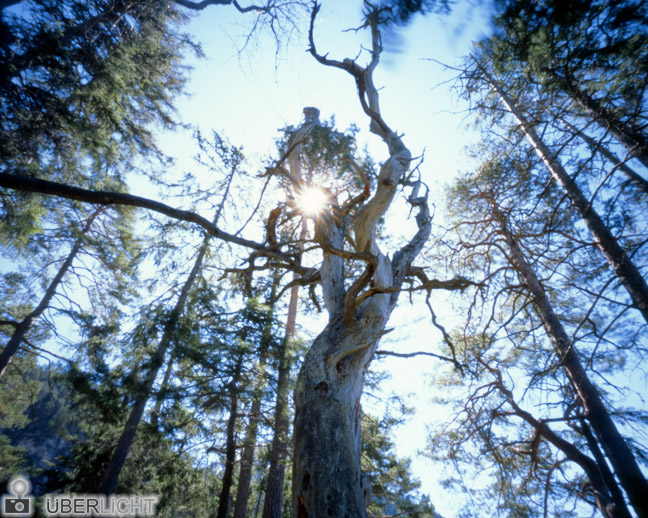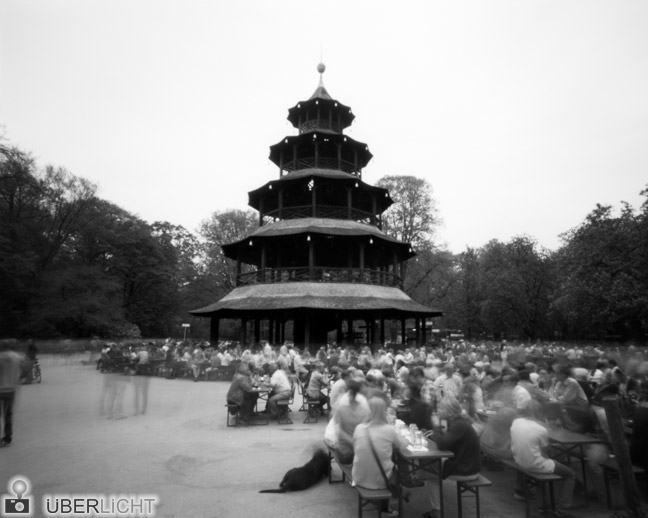It has been half a year now since it conquered our pinhole-loving photographer hearts by storm. Our curiosity had already been piqued last autumn when HARMAN technology announced the HARMAN TiTAN Pinhole Camera (for 4×5″ sheet film) developed in collaboration with Walker Cameras.

HARMAN TiTAN Pinhole Camera – © Überlicht
A lightweight camera to go
Due to its light and compact construction (less than 250 g / 9 oz.) the camera is made to be taken around. The additional equipment (the inevitable tripod and a sufficient amount of sheet film holders) may weigh a little more, yet we have spent many weekends hiking in the Alps or strolling through various cities over the past months without being sorry about it.

Mountain torrent in the Alps, Germany (2012), HARMAN TiTAN Pinhole Camera – © Überlicht
The camera
The pinhole camera construction is rather simple; technically speaking it consists of four parts:
- body with two tripod mounts, two spirit levels, accessory shoe, film holder slot and two cone clips
- cone 72 mm / 2.8″ (attached to the body by cone clips)
- pinhole f206 (attached to the cone by clockwise rotation)
- pinhole cover (film is being exposed by opening and closing the cap)
The injection moulded body made of ABS plastic is covered with an anti-slip coating that adds to the high-value appearance. Furthermore, all metal attachments are manufactured from stainless steel, which allows the camera to be used under raw weather conditions as well. The cone is not matt-finished on the inside, however there’s no need to fear undesired reflections. The camera’s overall dimension is about 16 cm x 14.5 cm x 9.3 cm / 6.3″ x 5.7″ x 3.7″, thus it will definitely find its place in every baggage.

Schmalensee in the Alps, Germany (2012), HARMAN TiTAN Pinhole Camera – © Überlicht

Contre-jour photograph of streambed in the Alps, Germany (2012), HARMAN TiTAN Pinhole Camera – © Überlicht
What’s in the box?
The ILFORD labelled cardboard box (HARMAN technology Ltd succeeded ILFORD Imaging UK Ltd in 2005) contains 10 sheets of each HARMAN DIRECT POSITIVE FB paper, ILFORD MULTIGRADE IV RC paper and ILFORD DELTA 100 professional film as well as a pinhole exposure calculator. The “ILFORD Pinhole Photography Kit” instruction manual is provided in four languages. HARMAN also anticipates all “unboxing videos” on YouTube with its own detailed contribution.

Contre-jour photograph of a tree, Germany (2012), HARMAN TiTAN Pinhole Camera – © Überlicht
Working with the camera
Handling the camera really is quite intuitive. Once the camera has been assembled and the quick release plate screwed tightly into one of the tripod mounts you can get started. It might be useful to own a second plate if you vary upright and horizontal format very often and do not want to spend your time screwing plates on and off – and due to instability do not want to rotate the tripod head by 90°. When the HARMAN TiTAN is mounted on the tripod and the sheet film holder is slid into the film holder slot the camera is ready to expose.
The exposure time can be determined with the enclosed exposure calculator (either by the means of a light meter or by estimating light values referring to the calculator symbols). Of course, the reciprocity failure of the specific film or paper type must be considered additionally. That is why we reverted to the collection of long exposure compensation charts (PDF) which we just extended by some more films.

Old Town Hall of Bamberg, Germany (2012), HARMAN TiTAN Pinhole Camera – © Überlicht

Departing ship in Bamberg, Germany (2012), HARMAN TiTAN Pinhole Camera – © Überlicht
As the pinhole cover fits very tightly to the pinhole (that’s good in some respects because the cover will not fall off accidentally), we have found it helpful to loosen it a little bit (only as far as the cap is still absolutely lightproof) in order not to shake the camera when finally opening the cover for the exposure. One last thing concerning the pinhole cover: do not remove or replace it by rotation as you might screw off the whole pinhole. Either way, it is necessary to remove the dark slide of the film holder prior to the cap. During the exposure time the cap can be dangling on its string, just be careful with strong breezes blowing it into your image area. Eventually the 72 mm / 2.8″ cone has quite a nice wide angle equivalent to 20 mm / 0.8″ on 35 mm format. Owning a view finder with the appropriate focal length to put it right into the accessory shoe is doubtlessly of great advantage when sighting subjects for a photograph.

Munich spring festival, Germany (2012), HARMAN TiTAN Pinhole Camera – © Überlicht
Over hill and dale
That is enough for the technical part. Now, what can you capture with the HARMAN TiTAN Pinhole Camera? We took it with us hiking through the Alps until heights of 1600 m / 5250 ft, faced the Rhine Falls together, strolled about the picturesque old town of Bamberg, visited the Munich spring festival (which is said to be the small Oktoberfest) and the Chinesischer Turm (“Chinese Tower”) in the English Garden. During all these excursions the camera told us that it likes subjects with every kind of movement (rushing waterfalls, spinning carrousels) and sometimes even being dazzled by the sunlight (but only for a short time, otherwise the film footage might get sunburnt). All the time it was firmly positioned on a compact travel tripod. Throughout our trips we were busy feeding it monochrome negative, colour negative and slide film. In return we were rewarded with wonderfully characteristic photographs.

Rhine Falls in Neuhausen, Switzerland (2012), HARMAN TiTAN Pinhole Camera – © Überlicht
Unlike us, even in draughty places with cold winds blowing the camera did not shiver (perhaps that is due to its aerodynamic shape), so all pictures turned out to be sharp.
Presumably as sharp as a pinhole photograph can become (it might be very difficult to find a camera obscura that produces sharper images on 4×5″), likewise a soft vignetting spreads out from the image margin. Astonishingly when photographing the sun directly there are only few sunbeams visible. For these reasons we guess that Walker Cameras knows how to manufacture very precise and smooth pinholes.
A greater variety
Apart from the 72 mm / 2.8″ focal length cone, new cones with 110 mm / 4.3″ and 150 mm / 5.9″ have been announced and are already available in the UK. While the 110 mm cone is featured with a f250 pinhole, the 150 mm cone holds the aperture f288. (Without exception all three cones and pinholes create the best possible sharpness according to Lord Rayleigh’s formula.) Furthermore a blank pinhole adapter is available for all those who would like to waive perfect sharpness and wish for more distinctive pictures (with irregular vignetting or blurrier detail). As all parts of the HARMAN TiTAN Pinhole Camera are interchangeable there is a multitude of scopes for design by now.
In March a prototype of a 8×10″ pinhole camera was shown for the first time. We are curious to get to know the growing HARMAN TiTAN Pinhole family.

Sylvenstein Reservoir, Germany (2012), HARMAN TiTAN Pinhole Camera – © Überlicht
By the way, the current kit containing the 72 mm / 2.8″ cone is priced at about £165 (Amazon UK) respectively $230 (Amazon US) or €240. And there is no need to hide behind the wooden competitor particularly in view of the fact that the HARMAN TiTAN is thoroughly British and even brings along some sheets of film and paper.

Chinesischer Turm (“Chinese Tower”) in the English Garden in Munich, Germany (2012), HARMAN TiTAN Pinhole Camera – © Überlicht
Ready for any venture
We are glad to have found such a special, forbearing and solid travel mate and are already looking forward to exploring further possibilities with this amazing camera.

Mole in Lake Constance, Germany (2012), HARMAN TiTAN Pinhole Camera – © Überlicht
The original German post has been published on Überlicht.de June 19th 2012.
posted August 18th 2012 by Marina Biederbick
categories: analogue, camera, photography, review
4 comments »
or changing bag
can be used. Handling the film material in the dark is facilitated by specific notches that are cut off one short side. On the one hand these notches mark the precise film type on the other hand they indicate on which side the emulsion is affixed.
























